Chesapeake Bay and Chesapeake Biological Laboratory field trip
Bill Dennison ·On 16 July, the Integration and Application Network staff met in Solomons, Maryland for a three hour cruise aboard the R/V Rachel Carson followed by a tour of the Chesapeake Biological Laboratory. The R/V Rachel Carson, skippered by Michael Hulme and crewed by Rob Nilsen, took us out to the center of the Bay for a hydrocast in 33 meters of water. Dave Loewensteiner helped out with the various scientific samplings and Jeremy Testa helped with the interpretation of the data. We found a shallow mixed surface layer above a fairly broad pycnocline (density transition between warmer, fresher surface water and cooler, saltier water). We plumbed the deep water containing low amounts of dissolved oxygen. This was a classic 'dead zone', but due to significant stirring and mixing due to recent wind events, even surface waters were depleted in dissolved oxygen.
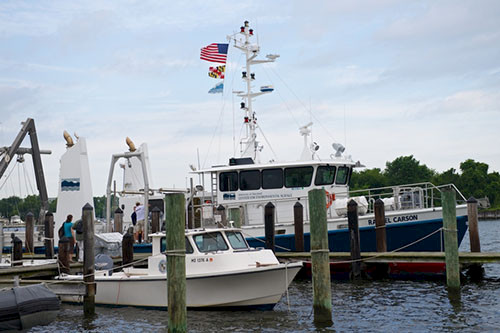
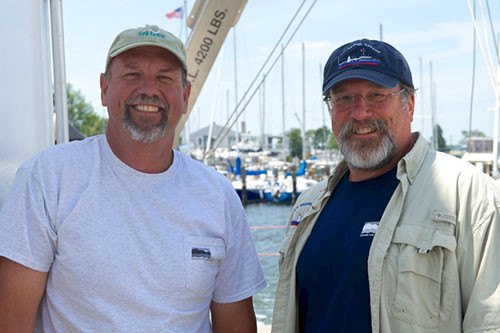
We traveled into the Patuxent River and used an otter trawl to sample fish, but the low water column oxygen levels apparently served as a deterrent to fish life. We only caught one lonely spot (Leiostomus xanthurus). Dave Loewensteiner commented that the commercial charter fishing boats in the Patuxent River move their fishing activities to the Tlighman Island region, and indeed we did not see any fishing boats. We also dredged for oysters (Crassostrea virginica), and found some large 3+ year old oysters. On our way back into port, Captain Michael pirouetted the Carson in front of the Chesapeake Biological Laboratory pier so that Cheryl Nemazie could take some photographs of the Carson at sea.

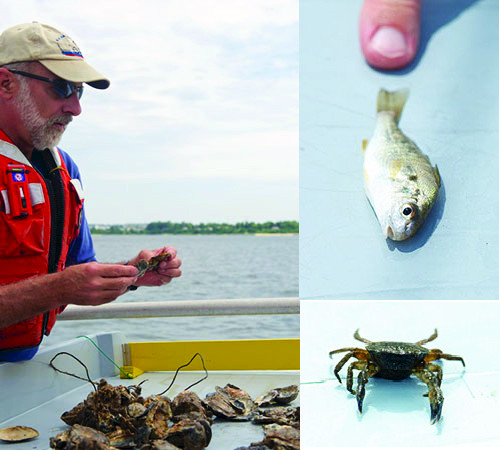
As the Carson was docking, we had a group sing-a-long of “Solomon’s Isle”, based on the Gilligan’s Island theme music from a 1960’s sitcom. The lyrics to this song are included at the end of this blog.
Following the Chesapeake cruise, we had lunch in the Alliance for Coastal Technologies/Maritime Environmental Resource Center building. Mario Tamburri and Dave Loewensteiner gave us a rundown of their sensor testing (currently pH sensors), as well as an overview of the ballast water treatment being conducted on a research barge currently moored in Baltimore Harbor. Walter Boynton joined us for lunch and provided some of his accumulated wisdom of Chesapeake Bay science and restoration, emphasizing the positive steps that result in improving conditions.
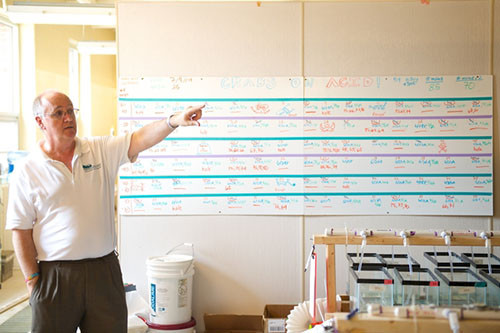
Tom Miller, Director of Chesapeake Biological Laboratory provided a historical perspective of the laboratory, beginning with Reginald Truitt in 1925. He also took us to the Bernie Fowler building to see some of the high tech laboratories measuring dissolved methane (Laura Lapham) and complex organic compounds (Michael Gonsior). We also visited the Nutrient Analytical Services Laboratory since many of the UMCES @ Chesapeake Bay Program staff use the nutrient data generated in this laboratory. Tom also took us to the Building and we visited Dave Secor’s fish ecology laboratory where Dave’s graduate students showed us the fish ear bones (otoliths) that they use to discern fish life histories and internal tracking devices to measure fish movements.
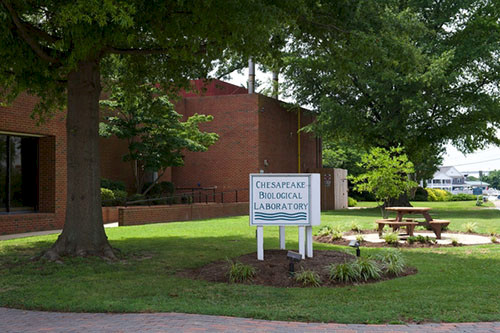
We stopped into historic Solomon’s House (ca. 1780) where the Visitor’s Center is located and checked out the displays. The docents that staff the Visitor’s Center are always helpful and enthusiastic, and I enjoy the compact displays. As we headed back across the Bay Bridge, I reflected on how the adage that “A bad day in the field is better than a good day in the office” could be amended to “A great day in the field is better than any day in the office”, thanks to Tom Miller, the crew of the Rachel Carson and the faculty/staff at CBL.

As promised, the lyrics to our song are as follows:
Solomon's Isle
16 July 2014
Just sit right back and you'll hear a tale,
A tale of a fateful trip
That started from this Solomon's dock
Aboard a research ship.
The mate was a mighty sailing man,
The skipper brave and sure.
Sixteen passengers set sail that day
For a three hour tour, a three hour tour.
The weather started getting rough,
The research ship was tossed,
If not for the courage of the fearless crew
The Carson would be lost, the Carson would be lost.
The ship set ground on the shore of Solomon's Isle
With Dennison
Guy Stephens too,
The Australian and her guy,
The dead zone star
The professor and web guys,
Here on Solomon's Isle.
So this is the tale of the scientists,
They're here for a long, long time,
They'll have to make the best of things,
It's an uphill climb.
The first mate and the Skipper too,
Will do their very best,
To make the others comfortable,
As they endure this little test.
No wifi, no data streaming, no lattes
Not a single luxury,
Like Robinson Crusoe,
As primitive as can be.
So join us here at CBL my friends,
You're sure to get a smile,
From sixteen stranded castaways,
Here on "Solomon's Isle."
About the author
Bill Dennison

Dr. Bill Dennison is a Professor of Marine Science and Vice President for Science Application at the University of Maryland Center for Environmental Science.
Next Post > Large Marine Ecosystems – An Australian in Paris
Comments
-
Melissa 11 years ago
Pirouetting research vessel- obtaining live oysters- having beautiful weather in the field AND with a song!
Excellent!
Also... you're very accurate with, “A great day in the field is better than any day in the office.”

